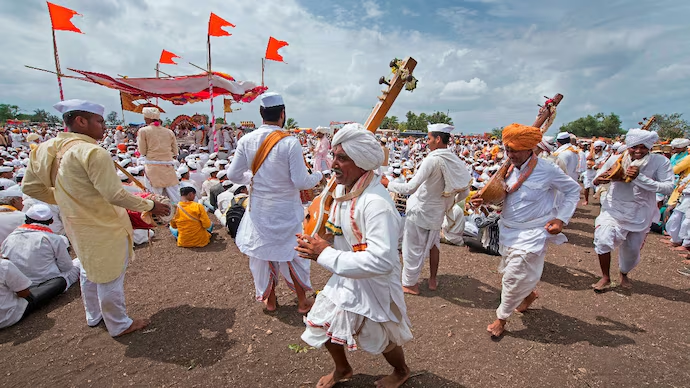The impact of the Hindu consolidation was such that the BJP won more number of seats where the Muslim population is over 20 per cent of the electorate.
The number for the Congress nosedived.
It also got the BJP the Gondiya seat for the first time, with a margin of over 60,000 votes.
The BJP won as much as 132 seats in the 288-member Maharashtra Assembly, while its Mahayuti alliance won 233 seats.
The MVA was reduced to 50 seats wherein Congress got 16, Shiv Sena (UBT) - 20 and NCP (Sharad Pawar faction) - 10 only.
Narendra Modi introduced a new rallying cry, "ek hain to safe hain" (together we are safe), a slogan designed to resonate with the Hindu electorate, emphasising unity as a defence against division.
This was not merely about communal unity but was portrayed as a broader appeal for national cohesion under BJP's stewardship.
The call seems to have resulted in silent consolidation of Hindu votes in favour of BJP and its allies.
The slogan was a direct counter to the narrative set by the opposition and was complemented by another slogan of Yogi Adityanath - 'Batenge toh katenge (Divided we fall). These played salutary roles in uniting the Hindu voters. Even Rahul Gandhi's Caste idiom was defeated in the process.
Political observers say Netas could be lambasted or credited for the landslide victory of the BJP-led Mahayuti in Maharashtra, it is a fact of life that Warkaris and Kirtankars, who hold huge sway in Maratha society, and helped consolidate Hindu votes have gone unnoticed.
This is how the elements of the Bhakti Movement brought about a silent movement by spreading the 'Hindu unity' message across Maharashtra.
This is where 2024 assembly elections in Maharashtra has emerged as yet another Hindutva Laboratory -- after Gujarat and Uttar Pradesh.
Significantly, Uttar Pradesh sends 80 MPs and Maharashtra is Number two in India in terms of sending largest number of lawmakers to Lok Sabha -- that is 48.
"Surprise or shock were the only two feelings that the Maharashtra election result delivered. Such was the scale of the BJP-led Mahayuti's victory that there was no room for ambivalence.
Opposition leaders didn't see this landslide coming, because it was a silent operation that was carried out over five months to consolidate Hindu votes. And elements of Maharashtra's Bhakti Movement -- Warkaris, kirtankars and bhajankaris -- helped in this state-wide movement," says an 'India Today' article.
As someone tries to understand the implications of these analyses, it will be relevant to look back.
More than seven years back, On March 11, 2017 - when the result came in for elections in five Indian states, especially the most populous Uttar Pradesh, it marked a leap forward for Hindu nationalists.
The success of the pro-Hindu Bharatiya Janata Party (BJP) rested safely on the shoulders of its leader and Prime Minister Narendra Modi as he packaged and presented his winning image of a Hindu zealot who struggles hard for India’s development.
Modi has to overcome multiple difficulties.
His decision to demonetize high-value currency notes in November 2016 pushed millions of poor into hardship but it was presented as fight against the black money of the rich and ultimately helped the BJP win back those voters.
That marked a new beginning for BJP's journey in Hindutva plank.
 |
| Blogger |
"If land is given for a [Muslim] cemetery in a village, it should also be given for [Hindu] cremation. If electricity is supplied during Ramadan, it should also be supplied during Diwali.
There should not be discrimination," Modi had said at a rally in UP in 2017 trying to take a shot at the rival Samajwadi Party that has deliberately cultivated an image of appeasing Muslims and also 'insulting' Hindus.
In Uttar Pradesh BJP's rivals Congress and Samajwadi parties tried to reach out to the Muslim minority either in 2017 or 2022 assembly polls. It made Modi’s task easier because 80 percent of Uttar Pradesh’s 200 million people are Hindu.
In 2024 assembly polls in Maharashtra almost the similar thing happened. The Congress and its allies NCP of Sena of Uddhav tried to win Muslim support.
Hence, the Hindu consolidation was easier.
Warkaris or Varkaris are pilgrims participating in the annual 250-km trek to the Lord Vitthal temple in Pandarpur (Solapur district), while kirtankars and bhajankars are those who sing verses and impart spiritual teachings. All the three are connected to 17th century Bhakti-poet Sant Tukaram, and are highly regarded in Maharashtra.
Political commentator Smita Deshmukh says the 'Sajag Raho' (Be Vigilant) campaign of the Rashtriya Swayamsewak Sangh (RSS), which involved 110 organisations, saw Warkaris, kirtankars and bhajankaris being roped in to spread the message of Hindu-unity across Maharashtra.
Author and historian Vaibhav Purandare believes that the BJP-led Mahayuti government's outreach to the Warkaris through fund allocation and pension had a big impact on the Assembly election.
"The impact of Warkari outreach, and how the Warkaris themselves transmitted the Mahayuti message has been felt across Maharashtra," says Purandare, the author of Shivaji: India's Great Warrior King and Bal Thackeray And The Rise of The Shiv Sena.
ends








No comments:
Post a Comment